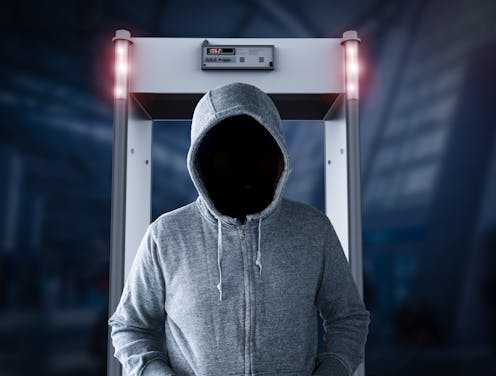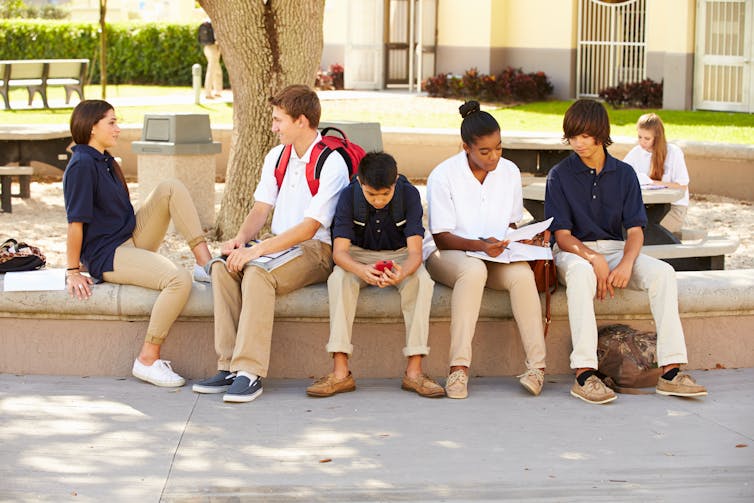Culture of trust is key for school safety
Researchers spent 16 years at a high school and observed security tighten and then loosen up again. What they found is that tighter security had the opposite of the intended effect.

When we first visited the school that is the focus of our forthcoming book, “Navigating Conflict: How Youth Handle Trouble in a High-Poverty School,” back in 1995, students were free to move about campus during lunch and other free periods and a culture of trust prevailed.
All that changed during the 1999-2000 school year. That’s when a new principal arrived at the school – a racially diverse, urban school in the Southwest. School renovation started with funding secured in the name of “safe schools.”
Bushes, trees and lockers were deemed security hazards and removed. Security gates and metal detectors were installed. School officials hired more security personnel and cut back students’ freedom of movement on campus dramatically. The school implemented “sweeps,” which meant any student without a signed pass found outside of class or the designated eating area would be escorted to a room called the “tank,” where they would be detained for the remainder of the school day. Students who violated restrictive rules related to movement on campus faced heavy discipline, which included an automatic parent conference followed by up to five days of out-of-school suspension.
Teachers and students began to voice concerns about the tightened security to each other and protested to the administration. All this set up an interesting case for us to examine as field researchers who study conflict in organizations.
Ironically, what we found is that the tightened security measures eroded the ethos of trust that facilitated peace among students. Notably, whereas before students settled conflict peacefully among themselves, now peer violence increased on campus, which is something we discovered in our field research and that was corroborated with school district and local law enforcement data. The average annual number of police calls from the campus nearly quadrupled after the implementation of the new security measures. Before the tightened security, school district data revealed that the school was as safe as any in the district, including suburban schools in the surrounding area.
We continued to observe the high school in the 2000s, returning for intensive fieldwork in 2008 after we learned the school had a new principal. Heavy disciplinary measures were relaxed, and students regained some freedom to move about campus.

The new principal recognized the importance of youth-centered teachers. Students once again turned to predominantly peaceful actions to handle conflicts, as found by our field data and corroborated by institutional data.
Why trust matters
From our perspective, what our 16 years of field experience at this particular school shows is that target hardening, more police presence and heavier discipline all have a corrosive effect on school culture and security. Our finding squares with other researchers who have found that schools with robust social trust experience less peer violence and conflict than schools where distrust prevails. The question is why?
Social trust leads to freedom of association and movement on campus for youth, which in turn enables youth to cross social divides and develop relationships with other kids. In a trusting environment, like the campus we studied, youth learn to empathize with peers who are different than they are, taking the hard edge off of stereotypes based on race. Inclusive student clubs, supported by teachers, reinforced a sense of social belonging on the campus. Even in this environment, some peer groups faced difficulties tied to their social identities, especially new immigrant youth from Mexico.
Youth skills
Another important lesson from our book is that youth continuously work on their skills at handling peer conflict. Coupled with the socialization learned from senior students and teachers, youth in schools where trust runs high develop skills for working out their troubles by talking, getting support from those not directly involved in disputes, avoiding one another until emotions cool, and educating or correcting troublesome youth.
Our point is not that youth should be left alone, or that they’re perfectly rational (they’re not) and will work out all their problems on their own.
Rather, it is our contention that youth have a pretty good fix on dangerous threats among their peers and can peg these threats, distinguishing them from the everyday troubles they face with one another. Adults need to pay close attention to the knowledge and skills of youth in handling peer conflict, and keep their ears to the ground as to what youth are saying about who’s truly dangerous and who’s not.
Youth-centered teachers
Another lesson is the importance of youth-centered teachers operating actively in the social environment of the school. These teachers are highly attentive to the education and safety of their students. They care about students’ lives, learning and comportment, and regard the entire school campus, not just their classroom, as their place.
Youth-centered teachers monitor students in and out of the classroom in supportive ways that facilitate building social trust. Student clubs figure prominently. This is because clubs offer opportunities for youth-centered teachers to open their classrooms as meeting spaces and collaborate with young people to formulate goals that respond to the changing needs of diverse students.
Youth-centered teachers also show a strong inclination to keep their commitments to youth and an inclusive school culture. They defend these practices during times of adversity.
Effective leadership
School principals are most effective when they know how to develop a shared vision with students and staff. In our view, these shared visions must be sustained from the bottom up rather than the top down. The most effective principals we observed knew how to empower youth-centered teachers and meaningful, inclusive youth agency in student governments and clubs. This led to social trust and a shared ability to respond to problems when they arose.
The bottom line, in our opinion, is that in an era of budgetary constraints, fostering an environment for youth-centered teachers and students to build cultures of trust will likely have better payoffs for school safety than further investments in the fortification of public school campuses.
Calvin Morrill receives funding from the National Science Foundation and the Spencer Foundation.
Michael Musheno receives funding from the National Science Foundation and the European Commission Marie Curie International Grant Program.
Read These Next
Resolve to network at your employer’s next ‘offsite’ – research shows these retreats actually help f
Because they can help you get to know more of your co-workers, offsites may build the kind of trust…
The celibate, dancing Shakers were once seen as a threat to society – 250 years later, they’re part
‘The Testament of Ann Lee,’ Mona Fastvold’s 2025 film, depicts part of the long history of Shaker…
From truce in the trenches to cocktails at the consulate: How Christmas diplomacy seeks to exploit s
World leaders like to talk up peace at Christmastime. But alongside the tales of seasonal breaks in…






